Construction of Network Diagram
VerifiedAdded on 2023/01/06
|10
|2813
|75
AI Summary
This document discusses the construction of a network diagram in project management, including the different methods used. It also explores the critical path approach and how to avoid exceeding the critical path. Additionally, it highlights the importance of quality management in project success. References are provided for further reading.
Contribute Materials
Your contribution can guide someone’s learning journey. Share your
documents today.
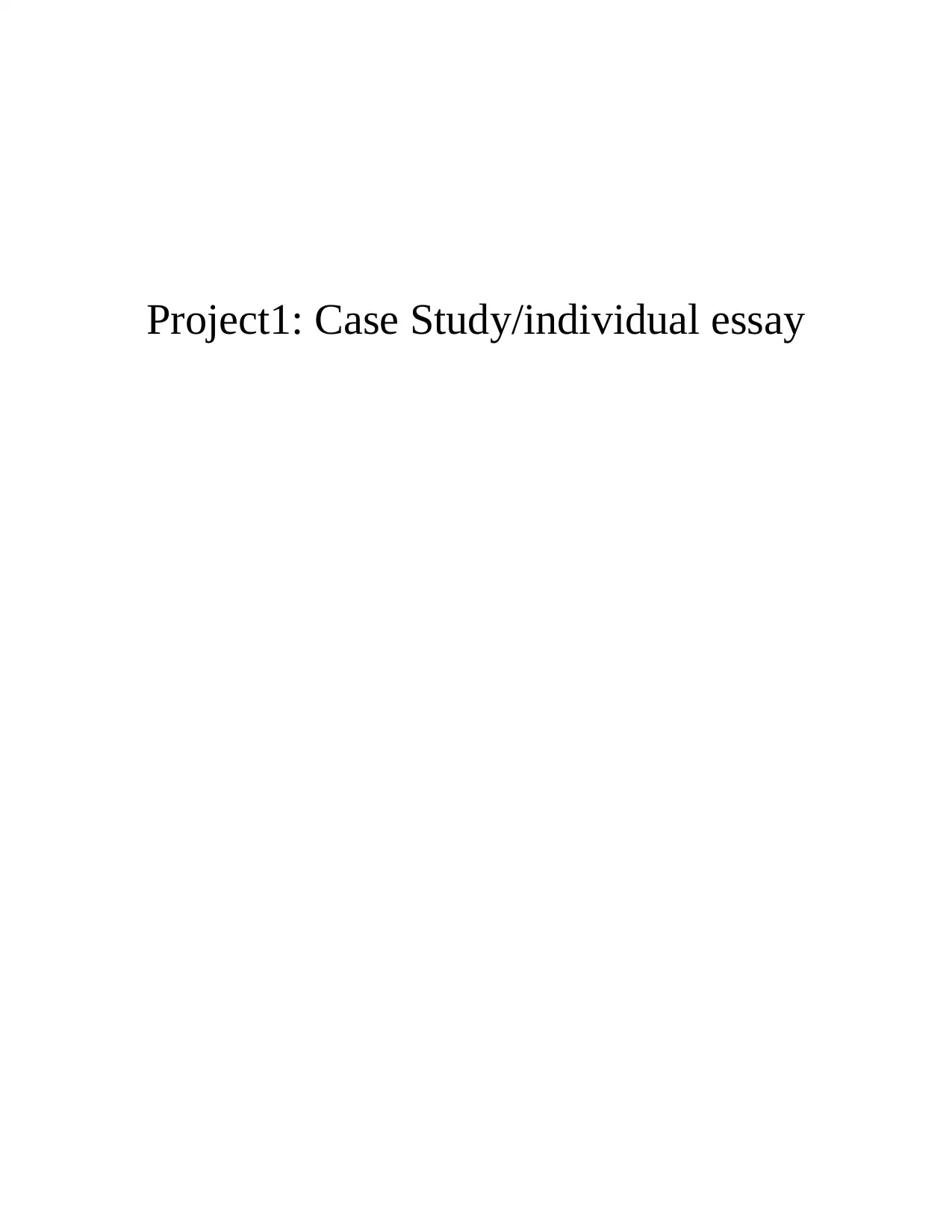
Project1: Case Study/individual essay
Secure Best Marks with AI Grader
Need help grading? Try our AI Grader for instant feedback on your assignments.
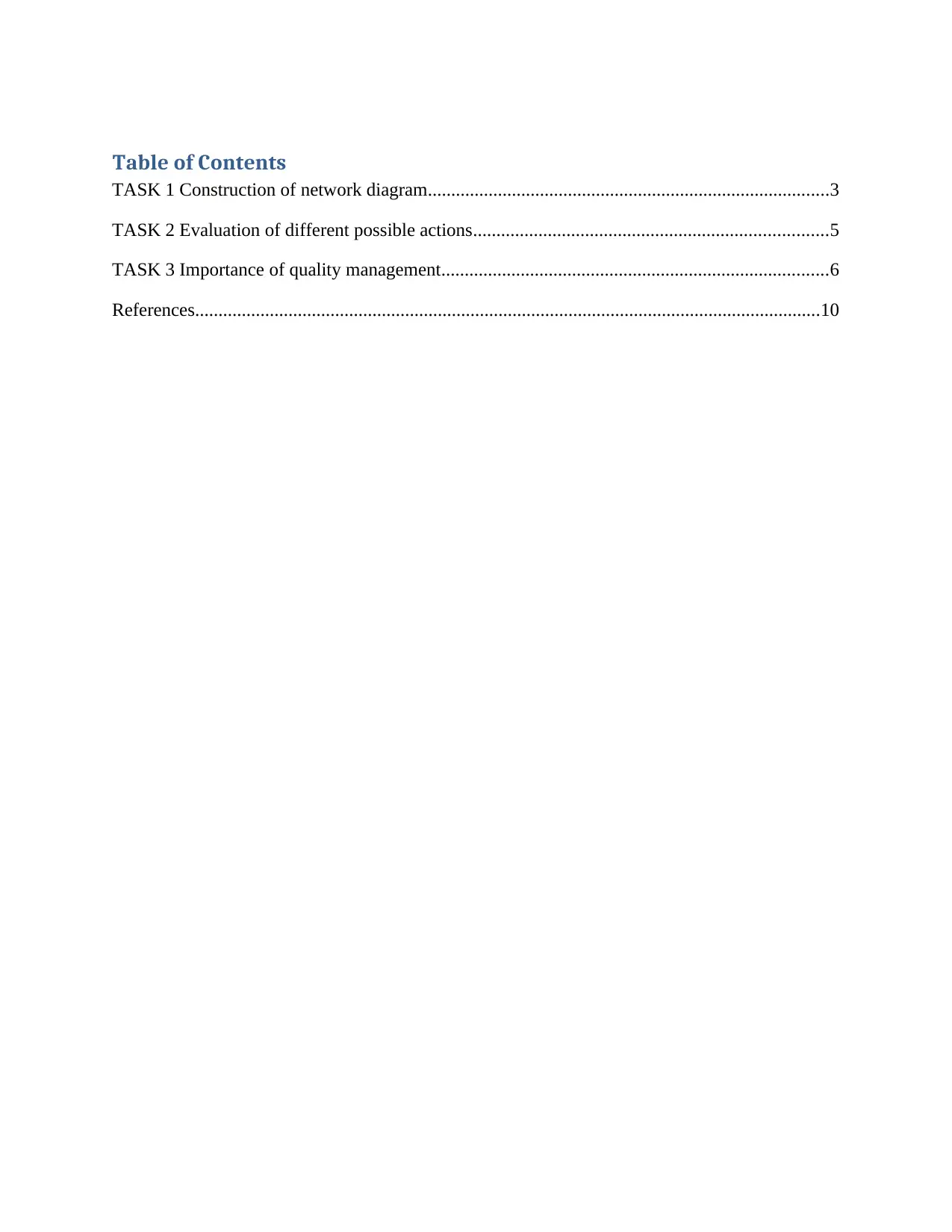
Table of Contents
TASK 1 Construction of network diagram......................................................................................3
TASK 2 Evaluation of different possible actions............................................................................5
TASK 3 Importance of quality management...................................................................................6
References......................................................................................................................................10
TASK 1 Construction of network diagram......................................................................................3
TASK 2 Evaluation of different possible actions............................................................................5
TASK 3 Importance of quality management...................................................................................6
References......................................................................................................................................10
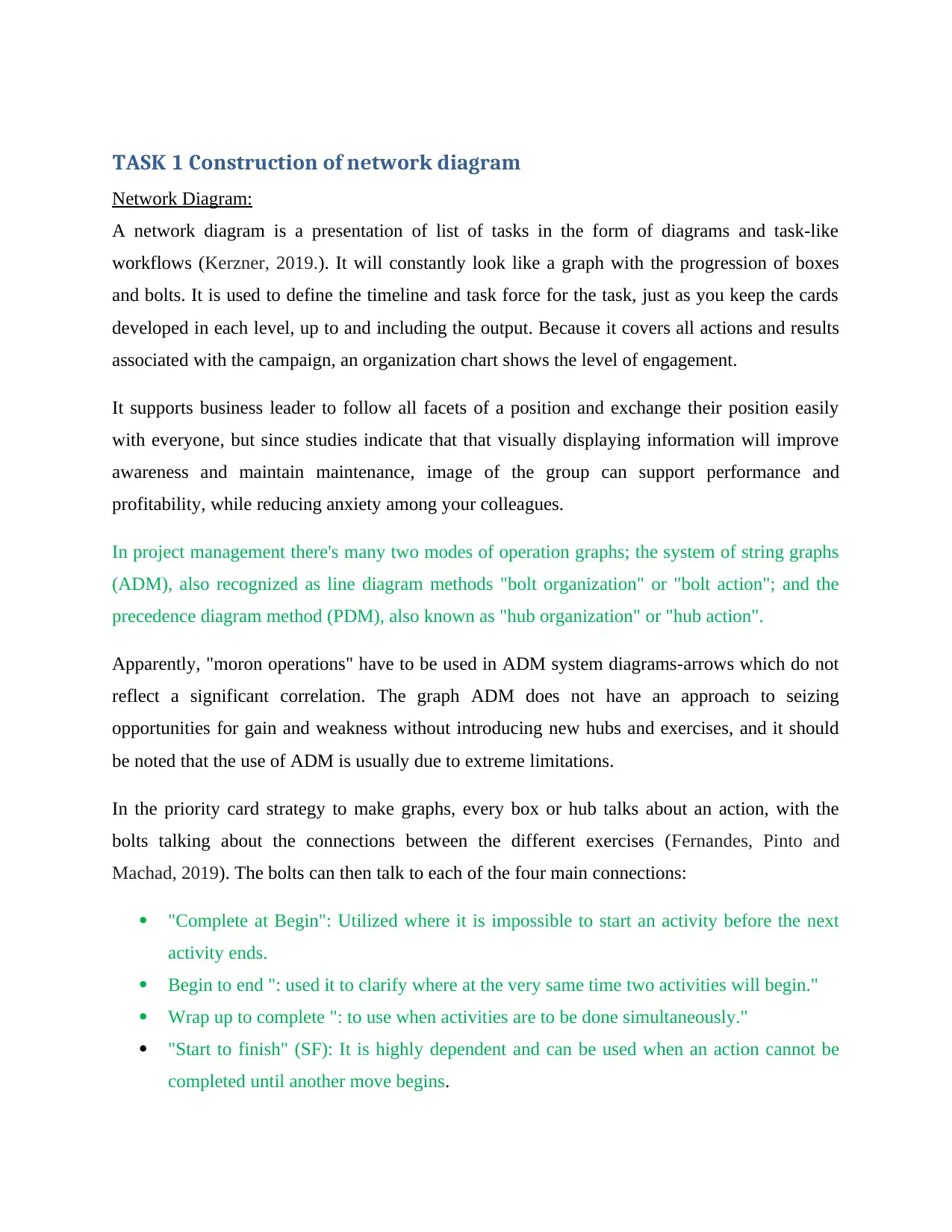
TASK 1 Construction of network diagram
Network Diagram:
A network diagram is a presentation of list of tasks in the form of diagrams and task-like
workflows (Kerzner, 2019.). It will constantly look like a graph with the progression of boxes
and bolts. It is used to define the timeline and task force for the task, just as you keep the cards
developed in each level, up to and including the output. Because it covers all actions and results
associated with the campaign, an organization chart shows the level of engagement.
It supports business leader to follow all facets of a position and exchange their position easily
with everyone, but since studies indicate that that visually displaying information will improve
awareness and maintain maintenance, image of the group can support performance and
profitability, while reducing anxiety among your colleagues.
In project management there's many two modes of operation graphs; the system of string graphs
(ADM), also recognized as line diagram methods "bolt organization" or "bolt action"; and the
precedence diagram method (PDM), also known as "hub organization" or "hub action".
Apparently, "moron operations" have to be used in ADM system diagrams-arrows which do not
reflect a significant correlation. The graph ADM does not have an approach to seizing
opportunities for gain and weakness without introducing new hubs and exercises, and it should
be noted that the use of ADM is usually due to extreme limitations.
In the priority card strategy to make graphs, every box or hub talks about an action, with the
bolts talking about the connections between the different exercises (Fernandes, Pinto and
Machad, 2019). The bolts can then talk to each of the four main connections:
"Complete at Begin": Utilized where it is impossible to start an activity before the next
activity ends.
Begin to end ": used it to clarify where at the very same time two activities will begin."
Wrap up to complete ": to use when activities are to be done simultaneously."
"Start to finish" (SF): It is highly dependent and can be used when an action cannot be
completed until another move begins.
Network Diagram:
A network diagram is a presentation of list of tasks in the form of diagrams and task-like
workflows (Kerzner, 2019.). It will constantly look like a graph with the progression of boxes
and bolts. It is used to define the timeline and task force for the task, just as you keep the cards
developed in each level, up to and including the output. Because it covers all actions and results
associated with the campaign, an organization chart shows the level of engagement.
It supports business leader to follow all facets of a position and exchange their position easily
with everyone, but since studies indicate that that visually displaying information will improve
awareness and maintain maintenance, image of the group can support performance and
profitability, while reducing anxiety among your colleagues.
In project management there's many two modes of operation graphs; the system of string graphs
(ADM), also recognized as line diagram methods "bolt organization" or "bolt action"; and the
precedence diagram method (PDM), also known as "hub organization" or "hub action".
Apparently, "moron operations" have to be used in ADM system diagrams-arrows which do not
reflect a significant correlation. The graph ADM does not have an approach to seizing
opportunities for gain and weakness without introducing new hubs and exercises, and it should
be noted that the use of ADM is usually due to extreme limitations.
In the priority card strategy to make graphs, every box or hub talks about an action, with the
bolts talking about the connections between the different exercises (Fernandes, Pinto and
Machad, 2019). The bolts can then talk to each of the four main connections:
"Complete at Begin": Utilized where it is impossible to start an activity before the next
activity ends.
Begin to end ": used it to clarify where at the very same time two activities will begin."
Wrap up to complete ": to use when activities are to be done simultaneously."
"Start to finish" (SF): It is highly dependent and can be used when an action cannot be
completed until another move begins.
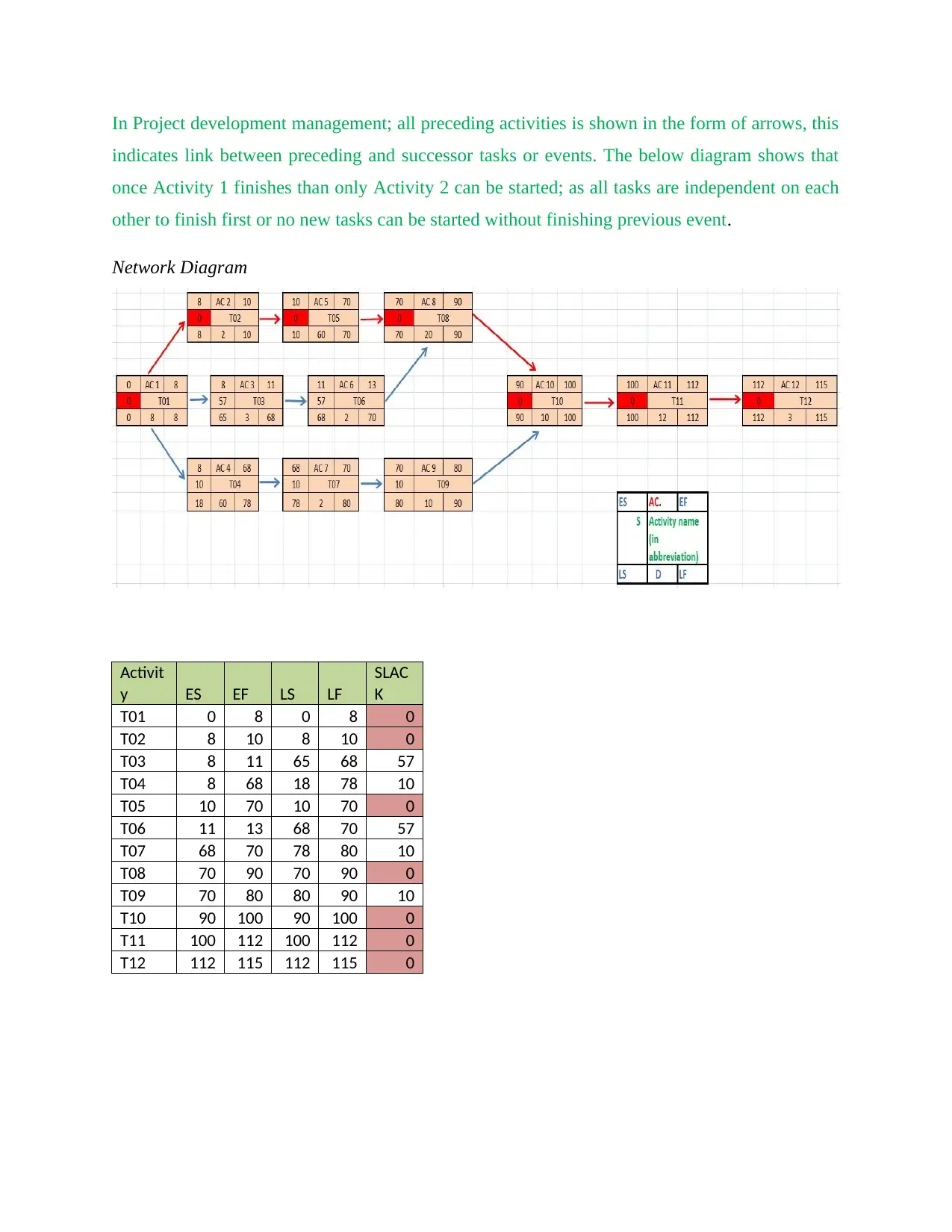
In Project development management; all preceding activities is shown in the form of arrows, this
indicates link between preceding and successor tasks or events. The below diagram shows that
once Activity 1 finishes than only Activity 2 can be started; as all tasks are independent on each
other to finish first or no new tasks can be started without finishing previous event.
Network Diagram
Activit
y ES EF LS LF
SLAC
K
T01 0 8 0 8 0
T02 8 10 8 10 0
T03 8 11 65 68 57
T04 8 68 18 78 10
T05 10 70 10 70 0
T06 11 13 68 70 57
T07 68 70 78 80 10
T08 70 90 70 90 0
T09 70 80 80 90 10
T10 90 100 90 100 0
T11 100 112 100 112 0
T12 112 115 112 115 0
indicates link between preceding and successor tasks or events. The below diagram shows that
once Activity 1 finishes than only Activity 2 can be started; as all tasks are independent on each
other to finish first or no new tasks can be started without finishing previous event.
Network Diagram
Activit
y ES EF LS LF
SLAC
K
T01 0 8 0 8 0
T02 8 10 8 10 0
T03 8 11 65 68 57
T04 8 68 18 78 10
T05 10 70 10 70 0
T06 11 13 68 70 57
T07 68 70 78 80 10
T08 70 90 70 90 0
T09 70 80 80 90 10
T10 90 100 90 100 0
T11 100 112 100 112 0
T12 112 115 112 115 0
Secure Best Marks with AI Grader
Need help grading? Try our AI Grader for instant feedback on your assignments.
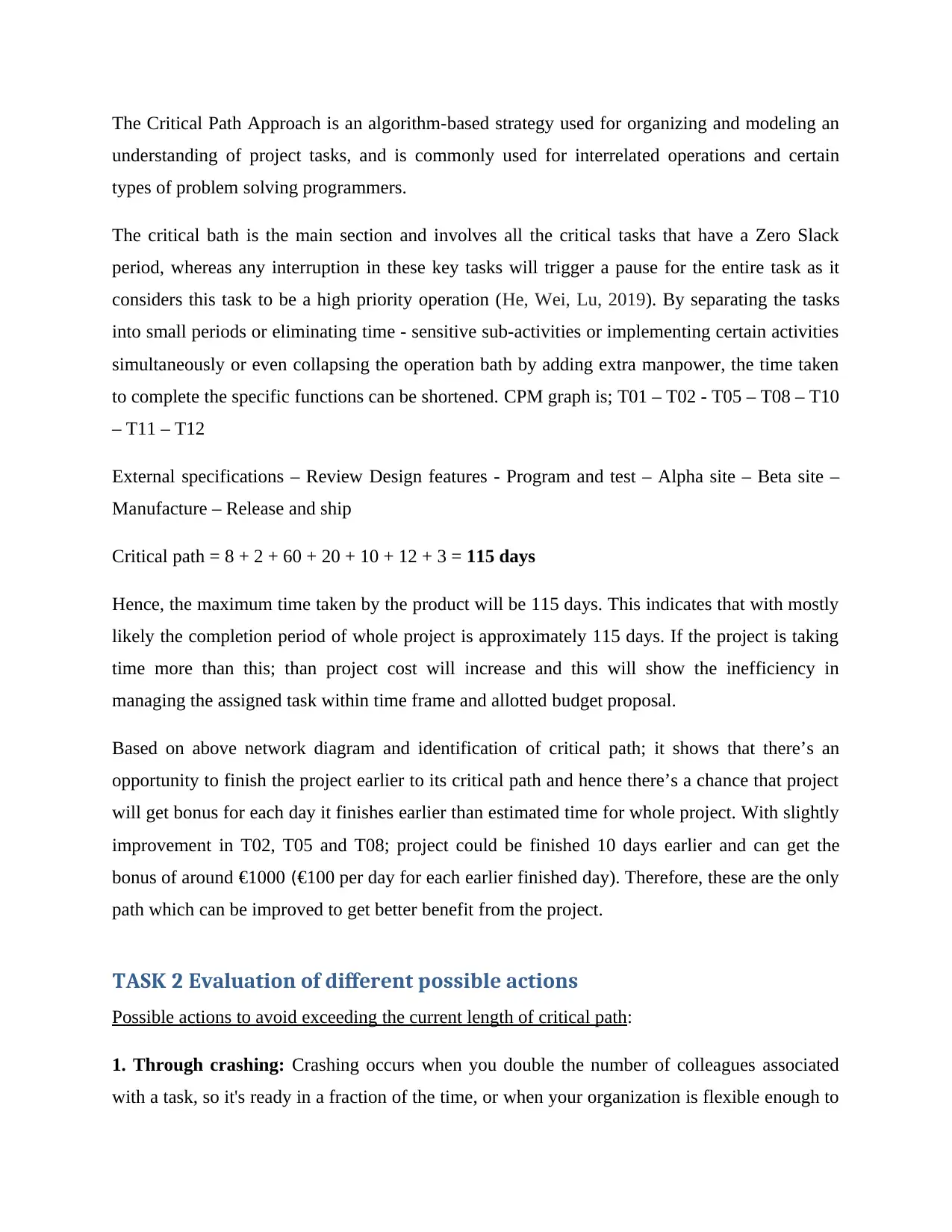
The Critical Path Approach is an algorithm-based strategy used for organizing and modeling an
understanding of project tasks, and is commonly used for interrelated operations and certain
types of problem solving programmers.
The critical bath is the main section and involves all the critical tasks that have a Zero Slack
period, whereas any interruption in these key tasks will trigger a pause for the entire task as it
considers this task to be a high priority operation (He, Wei, Lu, 2019). By separating the tasks
into small periods or eliminating time - sensitive sub-activities or implementing certain activities
simultaneously or even collapsing the operation bath by adding extra manpower, the time taken
to complete the specific functions can be shortened. CPM graph is; T01 – T02 - T05 – T08 – T10
– T11 – T12
External specifications – Review Design features - Program and test – Alpha site – Beta site –
Manufacture – Release and ship
Critical path = 8 + 2 + 60 + 20 + 10 + 12 + 3 = 115 days
Hence, the maximum time taken by the product will be 115 days. This indicates that with mostly
likely the completion period of whole project is approximately 115 days. If the project is taking
time more than this; than project cost will increase and this will show the inefficiency in
managing the assigned task within time frame and allotted budget proposal.
Based on above network diagram and identification of critical path; it shows that there’s an
opportunity to finish the project earlier to its critical path and hence there’s a chance that project
will get bonus for each day it finishes earlier than estimated time for whole project. With slightly
improvement in T02, T05 and T08; project could be finished 10 days earlier and can get the
bonus of around €1000 (€100 per day for each earlier finished day). Therefore, these are the only
path which can be improved to get better benefit from the project.
TASK 2 Evaluation of different possible actions
Possible actions to avoid exceeding the current length of critical path:
1. Through crashing: Crashing occurs when you double the number of colleagues associated
with a task, so it's ready in a fraction of the time, or when your organization is flexible enough to
understanding of project tasks, and is commonly used for interrelated operations and certain
types of problem solving programmers.
The critical bath is the main section and involves all the critical tasks that have a Zero Slack
period, whereas any interruption in these key tasks will trigger a pause for the entire task as it
considers this task to be a high priority operation (He, Wei, Lu, 2019). By separating the tasks
into small periods or eliminating time - sensitive sub-activities or implementing certain activities
simultaneously or even collapsing the operation bath by adding extra manpower, the time taken
to complete the specific functions can be shortened. CPM graph is; T01 – T02 - T05 – T08 – T10
– T11 – T12
External specifications – Review Design features - Program and test – Alpha site – Beta site –
Manufacture – Release and ship
Critical path = 8 + 2 + 60 + 20 + 10 + 12 + 3 = 115 days
Hence, the maximum time taken by the product will be 115 days. This indicates that with mostly
likely the completion period of whole project is approximately 115 days. If the project is taking
time more than this; than project cost will increase and this will show the inefficiency in
managing the assigned task within time frame and allotted budget proposal.
Based on above network diagram and identification of critical path; it shows that there’s an
opportunity to finish the project earlier to its critical path and hence there’s a chance that project
will get bonus for each day it finishes earlier than estimated time for whole project. With slightly
improvement in T02, T05 and T08; project could be finished 10 days earlier and can get the
bonus of around €1000 (€100 per day for each earlier finished day). Therefore, these are the only
path which can be improved to get better benefit from the project.
TASK 2 Evaluation of different possible actions
Possible actions to avoid exceeding the current length of critical path:
1. Through crashing: Crashing occurs when you double the number of colleagues associated
with a task, so it's ready in a fraction of the time, or when your organization is flexible enough to
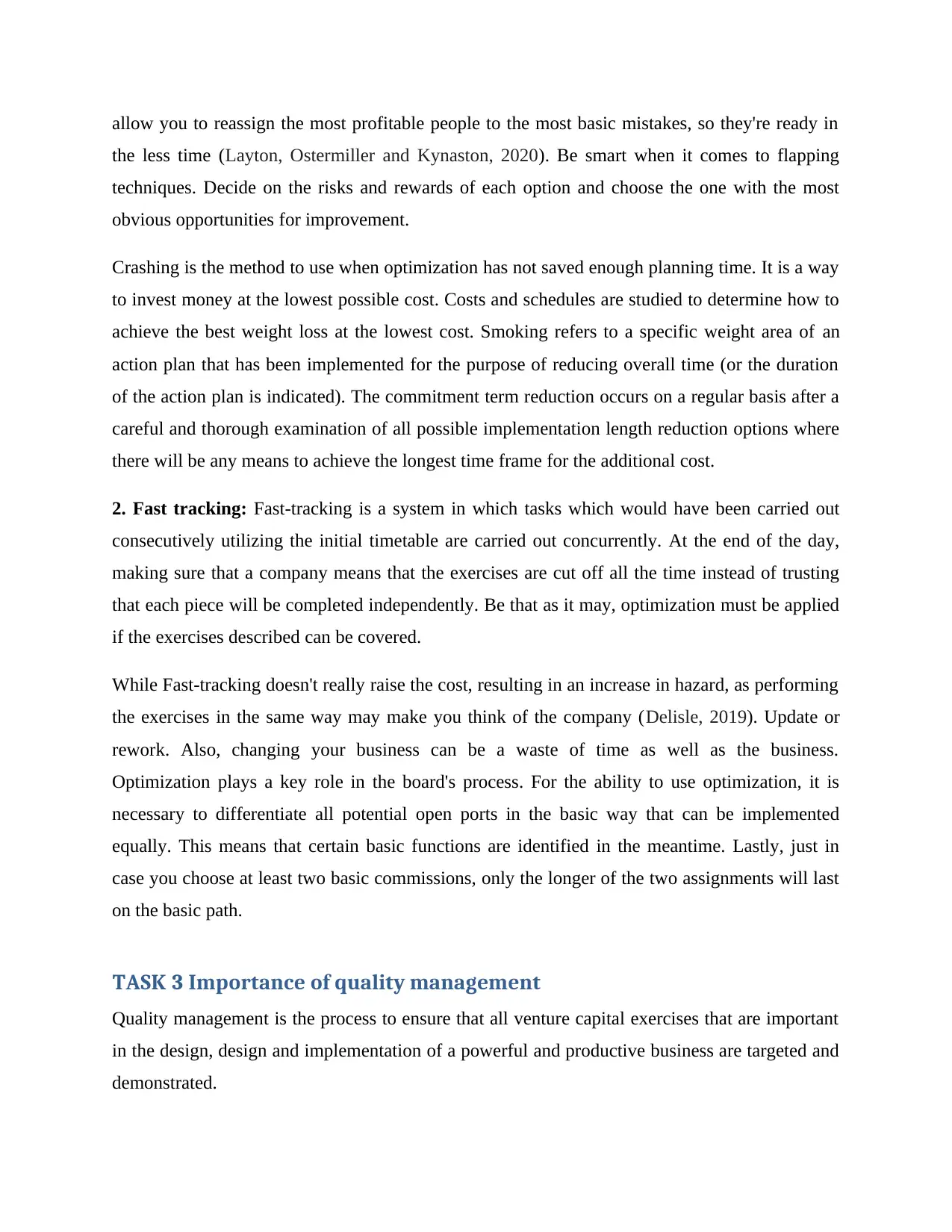
allow you to reassign the most profitable people to the most basic mistakes, so they're ready in
the less time (Layton, Ostermiller and Kynaston, 2020). Be smart when it comes to flapping
techniques. Decide on the risks and rewards of each option and choose the one with the most
obvious opportunities for improvement.
Crashing is the method to use when optimization has not saved enough planning time. It is a way
to invest money at the lowest possible cost. Costs and schedules are studied to determine how to
achieve the best weight loss at the lowest cost. Smoking refers to a specific weight area of an
action plan that has been implemented for the purpose of reducing overall time (or the duration
of the action plan is indicated). The commitment term reduction occurs on a regular basis after a
careful and thorough examination of all possible implementation length reduction options where
there will be any means to achieve the longest time frame for the additional cost.
2. Fast tracking: Fast-tracking is a system in which tasks which would have been carried out
consecutively utilizing the initial timetable are carried out concurrently. At the end of the day,
making sure that a company means that the exercises are cut off all the time instead of trusting
that each piece will be completed independently. Be that as it may, optimization must be applied
if the exercises described can be covered.
While Fast-tracking doesn't really raise the cost, resulting in an increase in hazard, as performing
the exercises in the same way may make you think of the company (Delisle, 2019). Update or
rework. Also, changing your business can be a waste of time as well as the business.
Optimization plays a key role in the board's process. For the ability to use optimization, it is
necessary to differentiate all potential open ports in the basic way that can be implemented
equally. This means that certain basic functions are identified in the meantime. Lastly, just in
case you choose at least two basic commissions, only the longer of the two assignments will last
on the basic path.
TASK 3 Importance of quality management
Quality management is the process to ensure that all venture capital exercises that are important
in the design, design and implementation of a powerful and productive business are targeted and
demonstrated.
the less time (Layton, Ostermiller and Kynaston, 2020). Be smart when it comes to flapping
techniques. Decide on the risks and rewards of each option and choose the one with the most
obvious opportunities for improvement.
Crashing is the method to use when optimization has not saved enough planning time. It is a way
to invest money at the lowest possible cost. Costs and schedules are studied to determine how to
achieve the best weight loss at the lowest cost. Smoking refers to a specific weight area of an
action plan that has been implemented for the purpose of reducing overall time (or the duration
of the action plan is indicated). The commitment term reduction occurs on a regular basis after a
careful and thorough examination of all possible implementation length reduction options where
there will be any means to achieve the longest time frame for the additional cost.
2. Fast tracking: Fast-tracking is a system in which tasks which would have been carried out
consecutively utilizing the initial timetable are carried out concurrently. At the end of the day,
making sure that a company means that the exercises are cut off all the time instead of trusting
that each piece will be completed independently. Be that as it may, optimization must be applied
if the exercises described can be covered.
While Fast-tracking doesn't really raise the cost, resulting in an increase in hazard, as performing
the exercises in the same way may make you think of the company (Delisle, 2019). Update or
rework. Also, changing your business can be a waste of time as well as the business.
Optimization plays a key role in the board's process. For the ability to use optimization, it is
necessary to differentiate all potential open ports in the basic way that can be implemented
equally. This means that certain basic functions are identified in the meantime. Lastly, just in
case you choose at least two basic commissions, only the longer of the two assignments will last
on the basic path.
TASK 3 Importance of quality management
Quality management is the process to ensure that all venture capital exercises that are important
in the design, design and implementation of a powerful and productive business are targeted and
demonstrated.
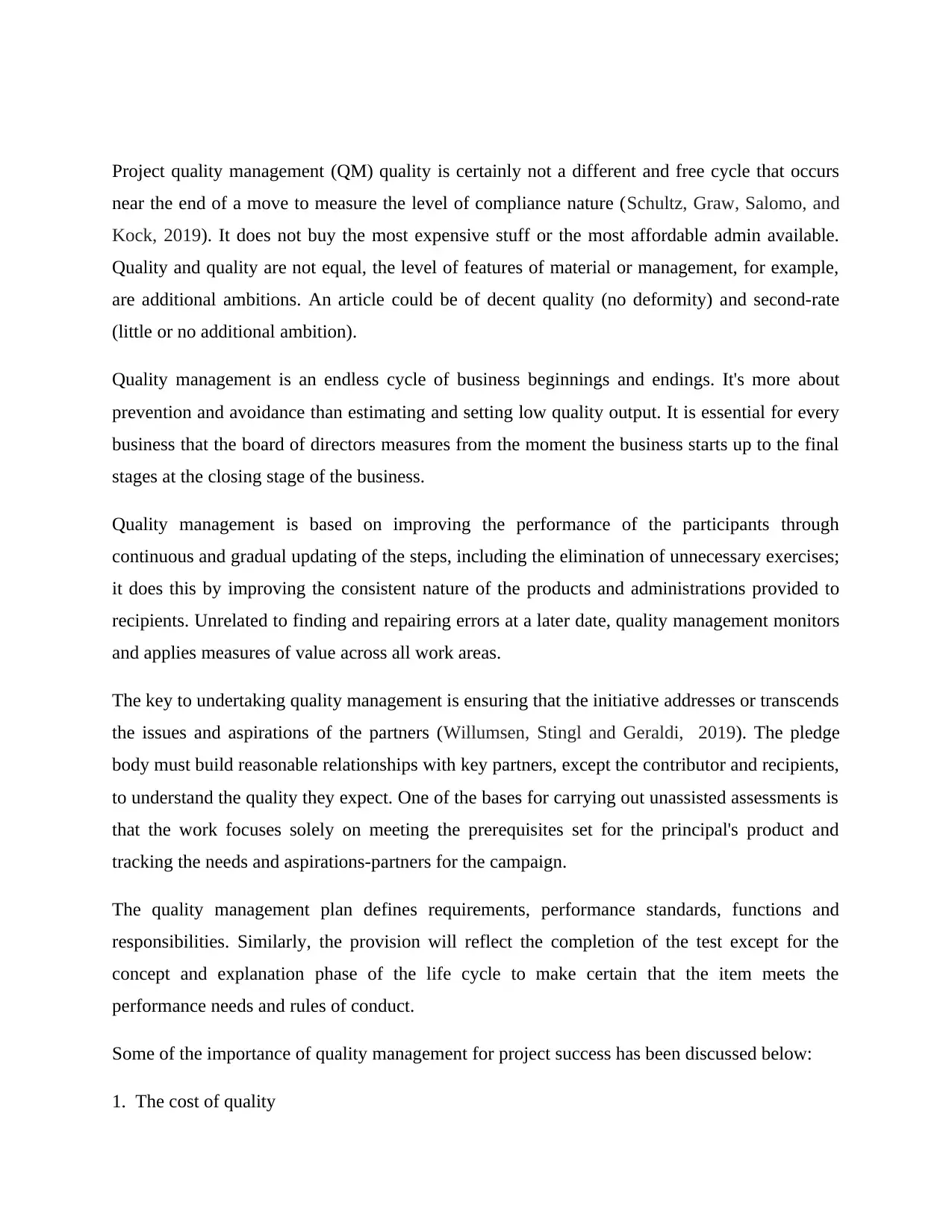
Project quality management (QM) quality is certainly not a different and free cycle that occurs
near the end of a move to measure the level of compliance nature (Schultz, Graw, Salomo, and
Kock, 2019). It does not buy the most expensive stuff or the most affordable admin available.
Quality and quality are not equal, the level of features of material or management, for example,
are additional ambitions. An article could be of decent quality (no deformity) and second-rate
(little or no additional ambition).
Quality management is an endless cycle of business beginnings and endings. It's more about
prevention and avoidance than estimating and setting low quality output. It is essential for every
business that the board of directors measures from the moment the business starts up to the final
stages at the closing stage of the business.
Quality management is based on improving the performance of the participants through
continuous and gradual updating of the steps, including the elimination of unnecessary exercises;
it does this by improving the consistent nature of the products and administrations provided to
recipients. Unrelated to finding and repairing errors at a later date, quality management monitors
and applies measures of value across all work areas.
The key to undertaking quality management is ensuring that the initiative addresses or transcends
the issues and aspirations of the partners (Willumsen, Stingl and Geraldi, 2019). The pledge
body must build reasonable relationships with key partners, except the contributor and recipients,
to understand the quality they expect. One of the bases for carrying out unassisted assessments is
that the work focuses solely on meeting the prerequisites set for the principal's product and
tracking the needs and aspirations-partners for the campaign.
The quality management plan defines requirements, performance standards, functions and
responsibilities. Similarly, the provision will reflect the completion of the test except for the
concept and explanation phase of the life cycle to make certain that the item meets the
performance needs and rules of conduct.
Some of the importance of quality management for project success has been discussed below:
1. The cost of quality
near the end of a move to measure the level of compliance nature (Schultz, Graw, Salomo, and
Kock, 2019). It does not buy the most expensive stuff or the most affordable admin available.
Quality and quality are not equal, the level of features of material or management, for example,
are additional ambitions. An article could be of decent quality (no deformity) and second-rate
(little or no additional ambition).
Quality management is an endless cycle of business beginnings and endings. It's more about
prevention and avoidance than estimating and setting low quality output. It is essential for every
business that the board of directors measures from the moment the business starts up to the final
stages at the closing stage of the business.
Quality management is based on improving the performance of the participants through
continuous and gradual updating of the steps, including the elimination of unnecessary exercises;
it does this by improving the consistent nature of the products and administrations provided to
recipients. Unrelated to finding and repairing errors at a later date, quality management monitors
and applies measures of value across all work areas.
The key to undertaking quality management is ensuring that the initiative addresses or transcends
the issues and aspirations of the partners (Willumsen, Stingl and Geraldi, 2019). The pledge
body must build reasonable relationships with key partners, except the contributor and recipients,
to understand the quality they expect. One of the bases for carrying out unassisted assessments is
that the work focuses solely on meeting the prerequisites set for the principal's product and
tracking the needs and aspirations-partners for the campaign.
The quality management plan defines requirements, performance standards, functions and
responsibilities. Similarly, the provision will reflect the completion of the test except for the
concept and explanation phase of the life cycle to make certain that the item meets the
performance needs and rules of conduct.
Some of the importance of quality management for project success has been discussed below:
1. The cost of quality
Paraphrase This Document
Need a fresh take? Get an instant paraphrase of this document with our AI Paraphraser
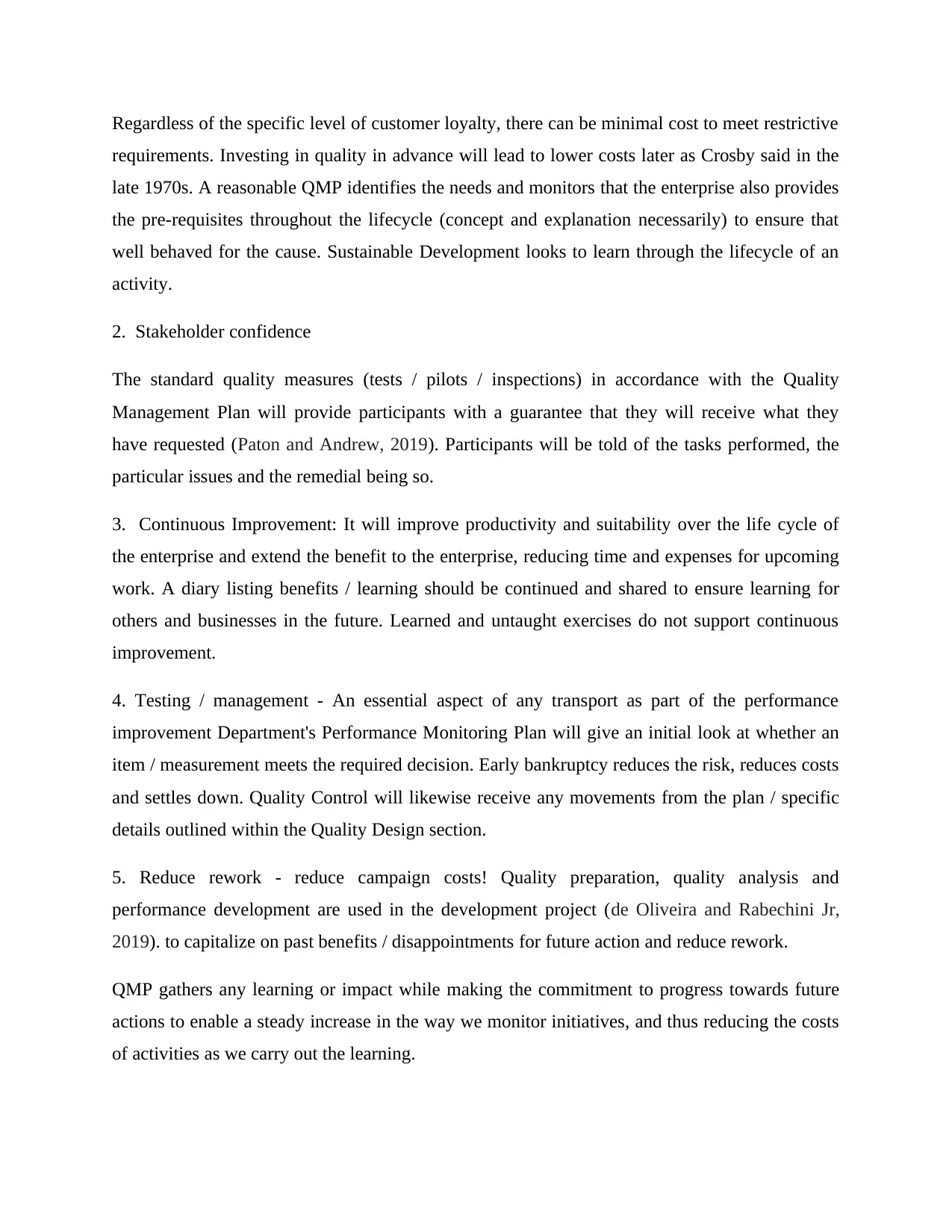
Regardless of the specific level of customer loyalty, there can be minimal cost to meet restrictive
requirements. Investing in quality in advance will lead to lower costs later as Crosby said in the
late 1970s. A reasonable QMP identifies the needs and monitors that the enterprise also provides
the pre-requisites throughout the lifecycle (concept and explanation necessarily) to ensure that
well behaved for the cause. Sustainable Development looks to learn through the lifecycle of an
activity.
2. Stakeholder confidence
The standard quality measures (tests / pilots / inspections) in accordance with the Quality
Management Plan will provide participants with a guarantee that they will receive what they
have requested (Paton and Andrew, 2019). Participants will be told of the tasks performed, the
particular issues and the remedial being so.
3. Continuous Improvement: It will improve productivity and suitability over the life cycle of
the enterprise and extend the benefit to the enterprise, reducing time and expenses for upcoming
work. A diary listing benefits / learning should be continued and shared to ensure learning for
others and businesses in the future. Learned and untaught exercises do not support continuous
improvement.
4. Testing / management - An essential aspect of any transport as part of the performance
improvement Department's Performance Monitoring Plan will give an initial look at whether an
item / measurement meets the required decision. Early bankruptcy reduces the risk, reduces costs
and settles down. Quality Control will likewise receive any movements from the plan / specific
details outlined within the Quality Design section.
5. Reduce rework - reduce campaign costs! Quality preparation, quality analysis and
performance development are used in the development project (de Oliveira and Rabechini Jr,
2019). to capitalize on past benefits / disappointments for future action and reduce rework.
QMP gathers any learning or impact while making the commitment to progress towards future
actions to enable a steady increase in the way we monitor initiatives, and thus reducing the costs
of activities as we carry out the learning.
requirements. Investing in quality in advance will lead to lower costs later as Crosby said in the
late 1970s. A reasonable QMP identifies the needs and monitors that the enterprise also provides
the pre-requisites throughout the lifecycle (concept and explanation necessarily) to ensure that
well behaved for the cause. Sustainable Development looks to learn through the lifecycle of an
activity.
2. Stakeholder confidence
The standard quality measures (tests / pilots / inspections) in accordance with the Quality
Management Plan will provide participants with a guarantee that they will receive what they
have requested (Paton and Andrew, 2019). Participants will be told of the tasks performed, the
particular issues and the remedial being so.
3. Continuous Improvement: It will improve productivity and suitability over the life cycle of
the enterprise and extend the benefit to the enterprise, reducing time and expenses for upcoming
work. A diary listing benefits / learning should be continued and shared to ensure learning for
others and businesses in the future. Learned and untaught exercises do not support continuous
improvement.
4. Testing / management - An essential aspect of any transport as part of the performance
improvement Department's Performance Monitoring Plan will give an initial look at whether an
item / measurement meets the required decision. Early bankruptcy reduces the risk, reduces costs
and settles down. Quality Control will likewise receive any movements from the plan / specific
details outlined within the Quality Design section.
5. Reduce rework - reduce campaign costs! Quality preparation, quality analysis and
performance development are used in the development project (de Oliveira and Rabechini Jr,
2019). to capitalize on past benefits / disappointments for future action and reduce rework.
QMP gathers any learning or impact while making the commitment to progress towards future
actions to enable a steady increase in the way we monitor initiatives, and thus reducing the costs
of activities as we carry out the learning.
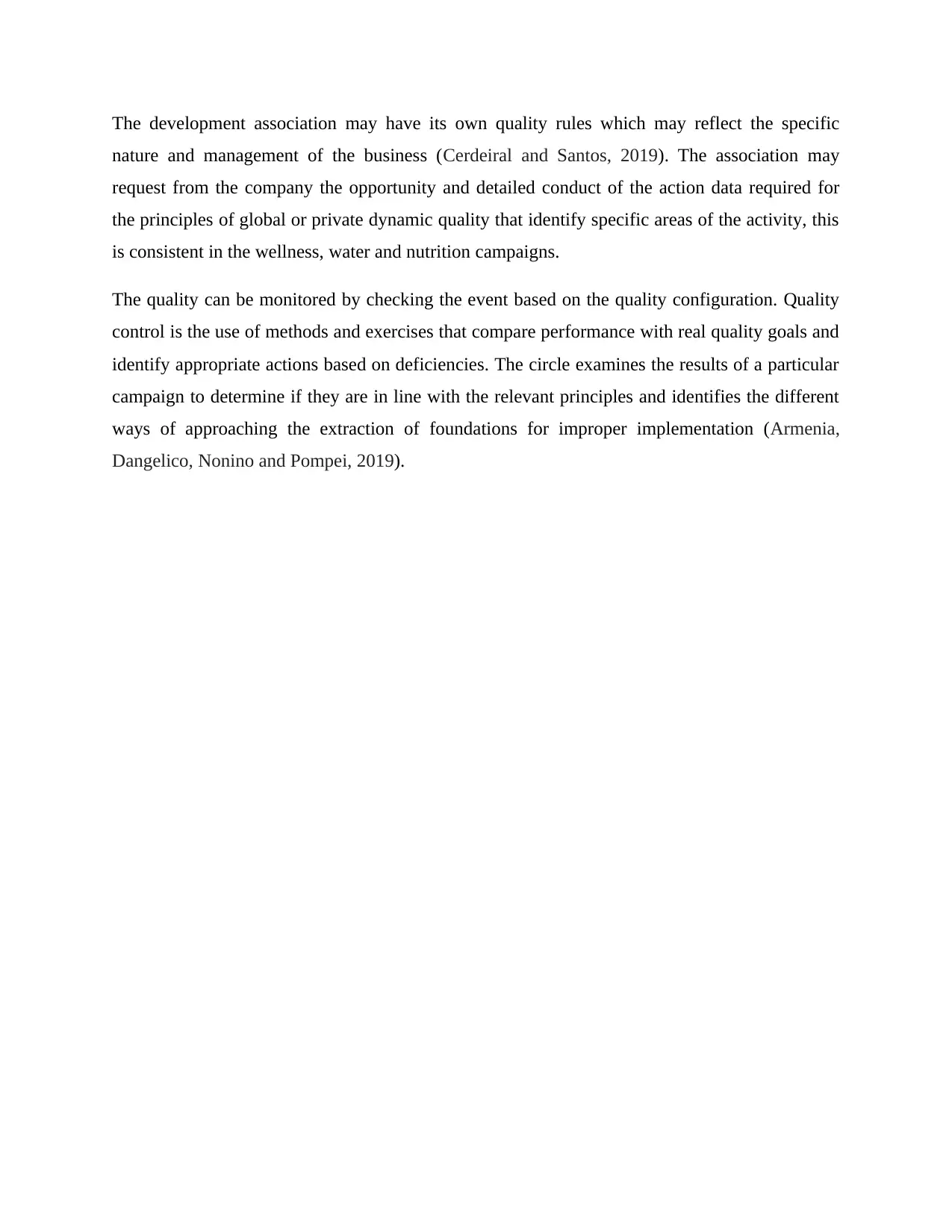
The development association may have its own quality rules which may reflect the specific
nature and management of the business (Cerdeiral and Santos, 2019). The association may
request from the company the opportunity and detailed conduct of the action data required for
the principles of global or private dynamic quality that identify specific areas of the activity, this
is consistent in the wellness, water and nutrition campaigns.
The quality can be monitored by checking the event based on the quality configuration. Quality
control is the use of methods and exercises that compare performance with real quality goals and
identify appropriate actions based on deficiencies. The circle examines the results of a particular
campaign to determine if they are in line with the relevant principles and identifies the different
ways of approaching the extraction of foundations for improper implementation (Armenia,
Dangelico, Nonino and Pompei, 2019).
nature and management of the business (Cerdeiral and Santos, 2019). The association may
request from the company the opportunity and detailed conduct of the action data required for
the principles of global or private dynamic quality that identify specific areas of the activity, this
is consistent in the wellness, water and nutrition campaigns.
The quality can be monitored by checking the event based on the quality configuration. Quality
control is the use of methods and exercises that compare performance with real quality goals and
identify appropriate actions based on deficiencies. The circle examines the results of a particular
campaign to determine if they are in line with the relevant principles and identifies the different
ways of approaching the extraction of foundations for improper implementation (Armenia,
Dangelico, Nonino and Pompei, 2019).
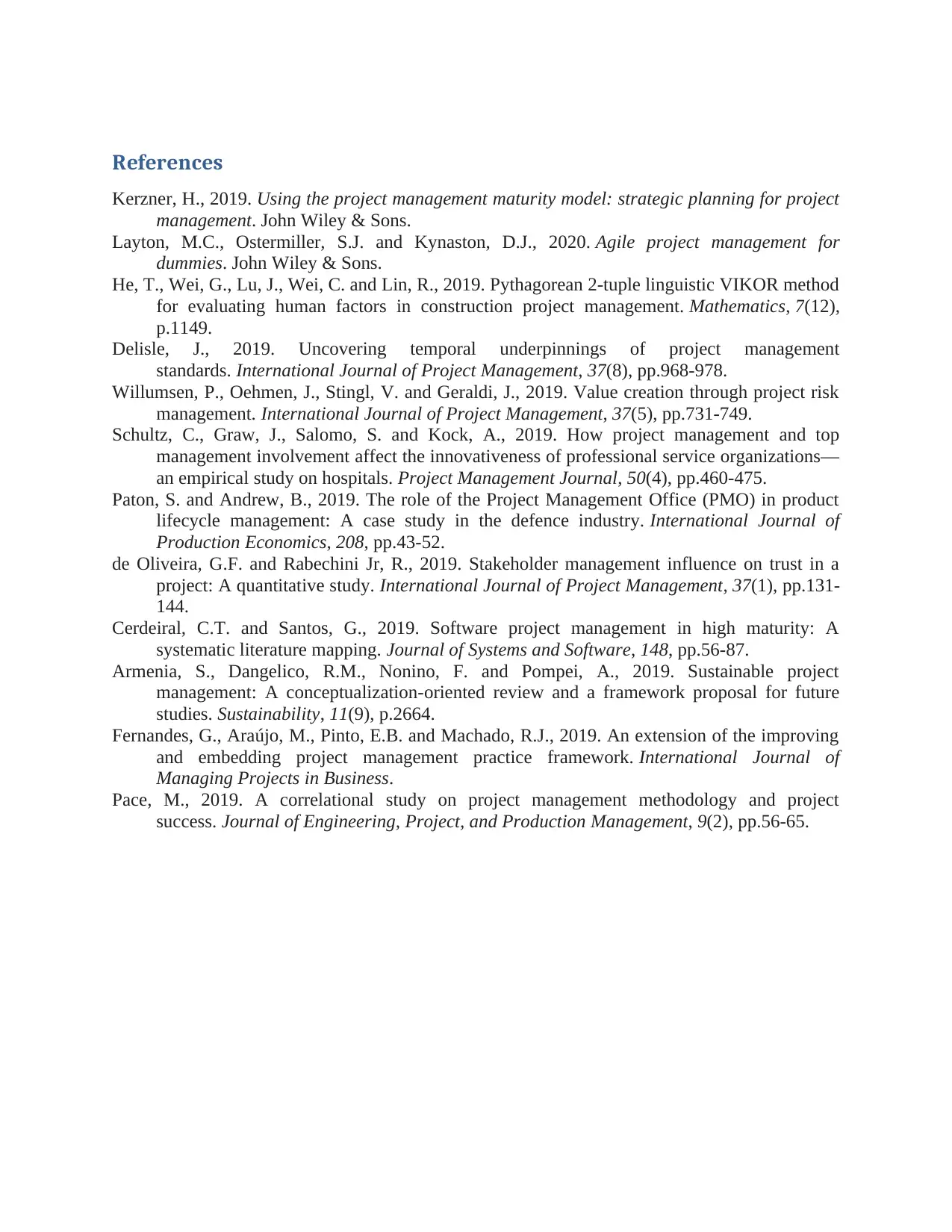
References
Kerzner, H., 2019. Using the project management maturity model: strategic planning for project
management. John Wiley & Sons.
Layton, M.C., Ostermiller, S.J. and Kynaston, D.J., 2020. Agile project management for
dummies. John Wiley & Sons.
He, T., Wei, G., Lu, J., Wei, C. and Lin, R., 2019. Pythagorean 2-tuple linguistic VIKOR method
for evaluating human factors in construction project management. Mathematics, 7(12),
p.1149.
Delisle, J., 2019. Uncovering temporal underpinnings of project management
standards. International Journal of Project Management, 37(8), pp.968-978.
Willumsen, P., Oehmen, J., Stingl, V. and Geraldi, J., 2019. Value creation through project risk
management. International Journal of Project Management, 37(5), pp.731-749.
Schultz, C., Graw, J., Salomo, S. and Kock, A., 2019. How project management and top
management involvement affect the innovativeness of professional service organizations—
an empirical study on hospitals. Project Management Journal, 50(4), pp.460-475.
Paton, S. and Andrew, B., 2019. The role of the Project Management Office (PMO) in product
lifecycle management: A case study in the defence industry. International Journal of
Production Economics, 208, pp.43-52.
de Oliveira, G.F. and Rabechini Jr, R., 2019. Stakeholder management influence on trust in a
project: A quantitative study. International Journal of Project Management, 37(1), pp.131-
144.
Cerdeiral, C.T. and Santos, G., 2019. Software project management in high maturity: A
systematic literature mapping. Journal of Systems and Software, 148, pp.56-87.
Armenia, S., Dangelico, R.M., Nonino, F. and Pompei, A., 2019. Sustainable project
management: A conceptualization-oriented review and a framework proposal for future
studies. Sustainability, 11(9), p.2664.
Fernandes, G., Araújo, M., Pinto, E.B. and Machado, R.J., 2019. An extension of the improving
and embedding project management practice framework. International Journal of
Managing Projects in Business.
Pace, M., 2019. A correlational study on project management methodology and project
success. Journal of Engineering, Project, and Production Management, 9(2), pp.56-65.
Kerzner, H., 2019. Using the project management maturity model: strategic planning for project
management. John Wiley & Sons.
Layton, M.C., Ostermiller, S.J. and Kynaston, D.J., 2020. Agile project management for
dummies. John Wiley & Sons.
He, T., Wei, G., Lu, J., Wei, C. and Lin, R., 2019. Pythagorean 2-tuple linguistic VIKOR method
for evaluating human factors in construction project management. Mathematics, 7(12),
p.1149.
Delisle, J., 2019. Uncovering temporal underpinnings of project management
standards. International Journal of Project Management, 37(8), pp.968-978.
Willumsen, P., Oehmen, J., Stingl, V. and Geraldi, J., 2019. Value creation through project risk
management. International Journal of Project Management, 37(5), pp.731-749.
Schultz, C., Graw, J., Salomo, S. and Kock, A., 2019. How project management and top
management involvement affect the innovativeness of professional service organizations—
an empirical study on hospitals. Project Management Journal, 50(4), pp.460-475.
Paton, S. and Andrew, B., 2019. The role of the Project Management Office (PMO) in product
lifecycle management: A case study in the defence industry. International Journal of
Production Economics, 208, pp.43-52.
de Oliveira, G.F. and Rabechini Jr, R., 2019. Stakeholder management influence on trust in a
project: A quantitative study. International Journal of Project Management, 37(1), pp.131-
144.
Cerdeiral, C.T. and Santos, G., 2019. Software project management in high maturity: A
systematic literature mapping. Journal of Systems and Software, 148, pp.56-87.
Armenia, S., Dangelico, R.M., Nonino, F. and Pompei, A., 2019. Sustainable project
management: A conceptualization-oriented review and a framework proposal for future
studies. Sustainability, 11(9), p.2664.
Fernandes, G., Araújo, M., Pinto, E.B. and Machado, R.J., 2019. An extension of the improving
and embedding project management practice framework. International Journal of
Managing Projects in Business.
Pace, M., 2019. A correlational study on project management methodology and project
success. Journal of Engineering, Project, and Production Management, 9(2), pp.56-65.
1 out of 10
Your All-in-One AI-Powered Toolkit for Academic Success.
+13062052269
info@desklib.com
Available 24*7 on WhatsApp / Email
![[object Object]](/_next/static/media/star-bottom.7253800d.svg)
Unlock your academic potential
© 2024 | Zucol Services PVT LTD | All rights reserved.